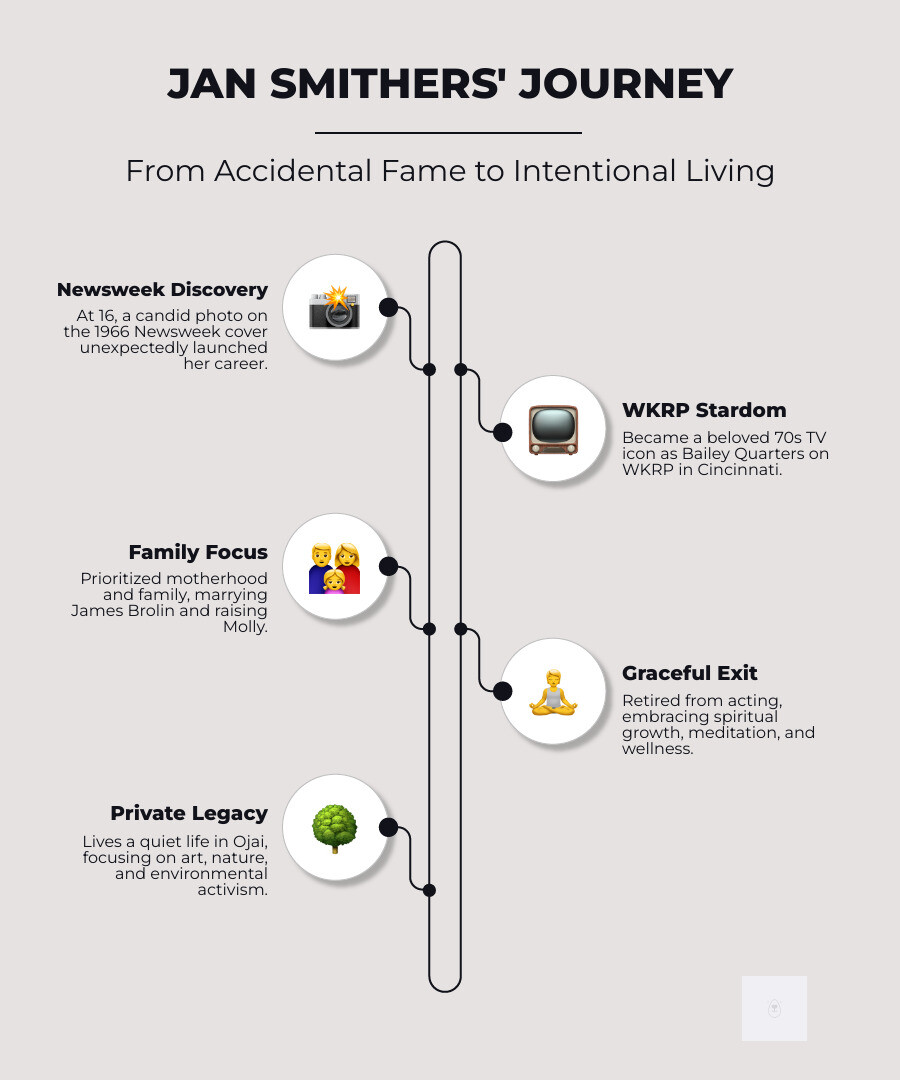
Why Jan Smithers Remains Hollywood’s Most Fascinating Enigma

Jan Smithers represents one of Hollywood’s most intriguing stories of accidental fame and intentional privacy. Here’s what you need to know about the actress who captured hearts as Bailey Quarters on WKRP in Cincinnati:
Quick Facts About Jan Smithers:
- Born: July 3, 1949, in North Hollywood, California
- Famous For: Playing Bailey Quarters on WKRP in Cincinnati (1978-1982)
- Career Start: Featured on Newsweek cover at age 16 in 1966
- Marriages: Kipp Whitman (1971-1972), James Brolin (1986-1995)
- Children: One daughter, Molly Brolin, with James Brolin
- Current Status: Retired from acting, living privately in California
At 16, Jan Smithers was simply skipping school at the beach when Newsweek reporters finded her for a story about American teenagers. That spontaneous motorcycle photo launched a career she never planned – and eventually walked away from at the height of her fame.
Her journey from accidental cover girl to beloved TV star to devoted mother offers fascinating insights into navigating fame on your own terms. In New York’s high-society circles, where image and authenticity often clash, Smithers’ story provides a masterclass in maintaining dignity while stepping away from the spotlight.
As R. Couri Hay, I’ve spent decades observing how celebrities handle fame and privacy in cultural centers like New York City, and Jan Smithers‘ approach to balancing career and personal life offers valuable lessons for anyone in the public eye. Her story demonstrates that true class means knowing when to say no to Hollywood’s demands.

Tip 1: How a Chance Encounter Can Define a Career
Picture this: you’re 16, skipping school for a perfect California beach day, and two strangers in suits walk up to you. For most teens, this would be terrifying. For Jan Smithers, it was the moment that accidentally launched her entire career.
That’s exactly what happened on a sunny day in 1966. Jan Smithers was just sitting on the sand, watching her friend surf, when Newsweek reporters spotted her. They were working on a story about American teenagers, and something about her natural, effortless beauty caught their eye.
The resulting photograph – Jan Smithers on the back of a motorcycle – landed on the March 21, 1966 cover of Newsweek. She wasn’t trying to be a model or actress. She was simply being herself, which made the image all the more captivating.

Almost overnight, Hollywood agents started calling. Commercial offers poured in. A career she never planned suddenly became her reality. It’s proof that sometimes the best opportunities come when you’re not even looking for them – a lesson that resonates with dreamers everywhere, from Los Angeles to New York City.
The Unlikely Path to Stardom
Jan Smithers grew up in Woodland Hills, California, with dreams of becoming an artist, not an actress. She’d enrolled at the prestigious Chouinard Art Institute (now the California Institute of the Arts) to study art. Acting wasn’t even on her radar.
But that Newsweek cover changed everything. With opportunities knocking, she made the bold decision to leave art school behind. Her mother became her biggest supporter, driving her all over Hollywood to meet with agents and managers.
Jan Smithers later recalled those early days: sleeping in the car with her mom, going from meeting to meeting, searching for someone who “communicated like a person.” Her mother was determined to find the right people to guide her daughter through this unexpected new world.
The transition from art student to actress wasn’t easy, but it opened doors she never imagined. Her story became an inspiration for creative types everywhere – including aspiring artists and performers in cultural hubs like New York City – proving that sometimes the most beautiful careers begin with the most unexpected moments.
What started as a day of playing hooky became the foundation of a career that would touch millions of viewers and create one of television’s most beloved characters.
Tip 2: The Enduring Power of an Iconic Role
While her Newsweek cover opened doors, it was Jan Smithers‘ portrayal of Bailey Quarters on WKRP in Cincinnati that transformed her from accidental cover girl into a genuine television icon. From 1978 to 1982, audiences fell in love with her understated brilliance across 86 memorable episodes.
WKRP in Cincinnati gave viewers a delightfully chaotic peek behind the scenes of a struggling radio station in Ohio. But what made the show truly special was its character dynamics – particularly the fascinating contrast between Jan Smithers‘ Bailey Quarters and Loni Anderson’s Jennifer Marlowe.
While Jennifer commanded attention as the station’s glamorous receptionist, Bailey quietly ran things as the program director and later assistant to the station manager. She was the thoughtful one in sensible sweaters while Jennifer impressd in designer outfits. This wasn’t just clever casting – it was brilliant storytelling that resonated with sophisticated audiences from coast to coast, including discerning viewers in New York City who appreciated nuanced character development.
The show’s lasting cultural impact speaks volumes. When The Paley Center for Media hosted “Baby, If You’ve Ever Wondered: A WKRP in Cincinnati Reunion” in 2014, it proved that decades later, people still cherished these characters. The reunion drew fans who remembered why Bailey Quarters felt so refreshingly real in a world of television stereotypes.
The Legacy of Bailey Quarters
What made Bailey Quarters so endearing? She represented something rare on television – quiet competence. While others grabbed headlines, Bailey solved problems. She evolved from a timid wallflower into a confident professional, showing viewers that growth happens gradually and authentically.
The genius of WKRP lay in how it balanced these two female archetypes without pitting them against each other. Bailey was the brains – compassionate, intelligent, and understated. Jennifer was the charm – glamorous, witty, and sharp-tongued. Both were essential to the station’s survival, just in different ways.
| Character | Role | Persona | Appeal |
|---|---|---|---|
| Bailey Quarters | Program Director/Assistant | Shy, intelligent, compassionate, understated | Relatable, inspiring, quiet competence |
| Jennifer Marlowe | Receptionist | Glamorous, confident, witty, sharp-tongued | Charismatic, aspirational, overt charm |
This dynamic created television magic that still feels fresh today. In a city like New York, where diverse personalities and authentic storytelling are celebrated, Jan Smithers‘ Bailey Quarters remains a beloved reminder that substance and style can coexist beautifully – you just need to know how to look for both.
Tip 3: Navigating Hollywood’s High-Profile Romances
When it comes to love in Hollywood, Jan Smithers experienced both the highs and challenges that come with high-profile relationships. Her romantic life became part of her public story, though she handled it with the same grace she brought to her career.
Her first marriage was to Kipp Whitman in 1971, but like many young Hollywood unions, it was brief, ending just a year later in 1972. While this relationship stayed relatively private, her second marriage would thrust her into the spotlight of Hollywood power couples.
In 1986, Jan Smithers married actor James Brolin, and suddenly she was part of one of Hollywood’s most talked-about couples. They had met on the set of the popular television series Hotel, where their on-screen chemistry translated into real-life romance. For nine years, they steerd the unique pressures of being a dual-celebrity household – something that resonates with many high-profile couples in places like New York City, where privacy and public life constantly intersect.
The marriage brought Jan Smithers into a blended family situation. She became stepmother to Brolin’s two sons from his previous marriage, while also welcoming their daughter, Molly Brolin, in 1987. Balancing career, new motherhood, and step-parenting requires tremendous skill – lessons that many New York families juggling demanding careers can relate to.
When their divorce was finalized in 1995, the media naturally speculated about the reasons. Some rumors suggested it was connected to James Brolin’s later relationship with Barbra Streisand. However, Jan Smithers has been refreshingly honest about setting the record straight. She clarified that their divorce happened five years before Brolin and Streisand began their relationship. As she explained it, they simply “started to wander” – a mature acknowledgment that sometimes good marriages simply run their course.
The Life of Jan Smithers Beyond the Screen
What makes Jan Smithers‘ story particularly compelling is how she chose to prioritize motherhood over maintaining her Hollywood status. When Molly was born, she made a decision that many working parents, especially in demanding cities like New York, understand deeply: she stepped away from her career to focus on raising her daughter.
“I had Molly and wanted to be in the country and get away from that world,” she explained. “I just wanted a different life, and we ended up getting divorced.” This honest reflection shows how major life changes often interconnect – her desire for a quieter, more grounded life ultimately contributed to the end of her marriage to Brolin.
Her dedication to Molly Brolin proved worthwhile. Today, Molly has grown into a talented metalsmith, maintaining strong relationships with both her parents. This success story offers hope to divorced families everywhere, showing that children can thrive when parents put their well-being first.
For New York families constantly balancing high-pressure careers with family life, Jan Smithers‘ choices provide a powerful example. She understood that true success isn’t always measured by staying in the spotlight. Sometimes it means knowing when to step back and focus on what matters most.
At R. Couri Hay Columns, we’ve seen how challenging it can be to maintain both public prominence and personal integrity. More info about building your personal brand with R. Couri Hay Columns can help you steer these complex decisions while staying true to your values.
Tip 4: The Art of a Graceful Exit and Reinvention
When Jan Smithers decided to step away from Hollywood, she didn’t just retire – she transformed her entire life. After her final acting credit in the 1987 film Mr. Nice Guy, she made a conscious choice that would surprise many in the entertainment industry. By 2004, she was officially done with acting, but this wasn’t an ending – it was a beautiful beginning.
Her post-Hollywood journey took a deeply spiritual direction that lasted 16 transformative years. Jan Smithers began traveling extensively to India, where she immersed herself in meditation and wellness practices. As she later shared, this period allowed her to “get out of myself” and change in profound ways.
The woman who once graced television screens was now finding peace in ancient practices and quiet reflection. Her spiritual journey wasn’t just about personal growth – it was about finding who she truly was beyond the cameras and scripts.
But Jan Smithers didn’t retreat entirely from the world. She channeled her newfound clarity into environmental activism, becoming a passionate advocate against nuclear energy. She even traveled to Washington to speak for solar energy as part of a subcommittee hearing.
While she humbly described her advocacy efforts as doing “a terrible job,” her passion remained undimmed. “I am so anti-nuclear energy,” she stated with conviction. This commitment shows how her spiritual growth translated into real-world action – a lesson that resonates with socially conscious New Yorkers who balance personal fulfillment with meaningful causes.
What is Jan Smithers doing now?
Today, Jan Smithers has found her sanctuary in Ojai, California, a tranquil artistic community that perfectly matches her evolved priorities. This peaceful town, known for its spiritual and creative residents, is worlds away from Hollywood’s intensity.
Her current life centers around art, nature, and personal well-being. She maintains strict privacy, with her social media accounts often locked – a deliberate choice that reflects her commitment to living authentically rather than performing for public consumption.
For New Yorkers juggling demanding careers and searching for deeper meaning, Jan Smithers’ story offers inspiring proof that reinvention is possible at any stage. Her journey from accidental fame to intentional privacy shows that true success might look completely different than what society expects.
She reminds us that sometimes the most courageous thing you can do is walk away from what everyone else thinks you should want, and instead choose what actually feeds your soul.
Tip 5: Understanding the Legacy of Jan Smithers
What makes Jan Smithers so fascinating isn’t just what she accomplished, but how she chose to live her life entirely on her own terms. Even decades after stepping away from Hollywood, she remains a captivating figure who proves that true elegance comes from authenticity, not fame.
Her career may not have been extensive, but it was certainly memorable. Beyond her iconic role as Bailey Quarters, Jan Smithers appeared in several notable films including Where the Lilies Bloom (1974) and Our Winning Season (1978). Television audiences also saw her in guest appearances on popular shows like The Love Boat, Murder, She Wrote, and Starsky and Hutch. Each role showcased her natural, understated talent that never felt forced or artificial.
What strikes many fans today is her enduring, natural beauty. Unlike many Hollywood stars who seem frozen in time through various improvements, Jan Smithers has aged gracefully, maintaining the same authentic charm that first captivated audiences. This genuine quality has always set her apart in an industry often criticized for superficiality.
One detail that adds to her authentic appeal is the small, permanent scar on her chin. This wasn’t theatrical makeup or a character trait – it came from a real car accident when she swerved to avoid another driver and hit a telephone pole. Rather than hide this imperfection, she wore it as part of who she was, embodying the kind of genuine confidence that resonates with sophisticated audiences, particularly in discerning cultural centers like New York City.
Lesser-Known Facts
The story of Jan Smithers becomes even more intriguing when you find the fascinating details most people never knew. In the early 1970s, she was actually the co-lead singer of a band called Hot Cup of Friends – proving her creative talents extended far beyond acting into music as well.
Her famous Newsweek cover truly was a complete accident. She wasn’t seeking stardom or even considering an entertainment career. This initial hesitation with acting and lack of burning ambition for fame perhaps explains why she was eventually so comfortable walking away from it all when motherhood called.
The car accident that left her chin scar wasn’t her only brush with unexpected life changes. Her entire career began with that chance encounter on the beach, continued through serendipitous meetings, and concluded with her deliberate choice to prioritize family over fame.
Even her living arrangements tell a story of someone following her heart rather than convention. After initially retiring to Halifax, Nova Scotia, she later moved back to California, settling in the artistic community of Ojai – a place known for natural beauty and creative residents who value substance over celebrity.
Her daughter, Molly Brolin, became a successful metalsmith, carrying on a creative lineage that perhaps stems from Jan Smithers‘ own early passion for art at the Chouinard Art Institute. It’s a beautiful example of how artistic spirit can flow through generations, even when careers take completely different paths.
These details create a rich portrait that goes far beyond her television fame, offering fascinating insights for fans in New York and everywhere who appreciate the depth and authenticity behind a truly remarkable public figure.
Frequently Asked Questions about Jan Smithers
Why did Jan Smithers leave acting?
The answer to this question reveals the heart of what makes Jan Smithers such a fascinating figure in Hollywood history. She made a deliberate choice that many celebrities find impossible to make – she walked away from fame to prioritize what truly mattered to her.
Jan Smithers left acting primarily to become a full-time mother to her daughter, Molly Brolin, born in 1987. As she put it simply, “I had Molly and wanted to be in the country and get away from that world. I just wanted a different life.” This wasn’t a gradual fade from the spotlight – it was an intentional decision to step back from Hollywood’s demands.
The pressures of maintaining a career in entertainment while raising a child proved incompatible with the kind of mother she wanted to be. Her choice resonates particularly with parents in demanding cities like New York, where balancing high-profile careers with family life presents similar challenges. Jan Smithers chose authenticity over celebrity, family over fame – a decision that speaks to her character and values.
Who was Jan Smithers married to?
Jan Smithers experienced two marriages, each marking different chapters in her life journey. Her first marriage was to Kipp Whitman, lasting from 1971 to 1972. This brief union occurred during her early years in Hollywood, before her breakthrough role on WKRP in Cincinnati.
Her second marriage brought her into the orbit of Hollywood royalty when she wed actor James Brolin in 1986. They met on the set of the television series Hotel, where their professional relationship blossomed into romance. This nine-year marriage, lasting until 1995, was her most public relationship and brought her daughter Molly into the world.
The marriage to Brolin also made Jan Smithers a stepmother to his two sons from a previous marriage. When their divorce was finalized in 1995, she was careful to clarify that it occurred five years before Brolin began his relationship with Barbra Streisand, dispelling any rumors about the timing. She described their split as amicable, explaining that they simply “started to wander” – a mature perspective on a relationship that had run its course.
What is the story behind the Jan Smithers Newsweek cover?
The Jan Smithers Newsweek cover story is perhaps one of Hollywood’s most charming tales of accidental findy. Picture this: it’s 1966, and a 16-year-old Jan Smithers is doing what many teenagers do – skipping school for a day at the beach.
She was sitting alone on the sand, watching her friend surf, when two men in suits approached her. They weren’t talent scouts or Hollywood agents – they were Newsweek reporters working on a feature story titled “The Teen-Agers,” meant to capture the essence of American youth in the turbulent 1960s.
The photograph that would change her life was completely candid – Jan Smithers riding on the back of a friend’s motorcycle, embodying the free-spirited nature of her generation. When that image graced the March 21, 1966, cover of Newsweek, it unexpectedly launched her into the public eye.
This serendipitous moment led to a flood of commercial work and offers from Hollywood agents. Her mother became her champion, driving all over Los Angeles, sleeping in the car between meetings, searching for someone who “communicated like a person.” It’s a reminder that sometimes the most significant moments in our lives happen when we least expect them – a story that continues to inspire dreamers in creative centers like New York City and beyond.
A Life Lived with Intention
Jan Smithers‘ story reads like a masterclass in authentic living. From that spontaneous moment on a California beach at 16 to her quiet life in Ojai today, she’s shown us what it means to make choices based on personal values rather than public expectations.
What makes her journey so fascinating isn’t just the accidental fame or the beloved TV role. It’s how she consistently chose substance over celebrity at every turn. When Hollywood came calling after that Newsweek cover, she could have easily gotten swept up in the glamour. Instead, she approached it thoughtfully, with her mother by her side, looking for people who “communicated like a person.”
Even at the height of her success as Bailey Quarters, she never lost sight of what truly mattered. When motherhood called, she didn’t hesitate to step away from the spotlight. When spiritual growth beckoned, she spent 16 years traveling to India, seeking meaning beyond fame. When environmental causes stirred her passion, she spoke up, even admitting she might have done “a terrible job” but standing firm in her convictions.
Her approach offers valuable lessons for anyone navigating success, whether you’re in New York City’s world or anywhere else. Jan Smithers proves that true grace isn’t about staying in the spotlight—it’s about knowing when to step away and create the life you actually want.
In our celebrity-obsessed culture, her story feels revolutionary. She chose privacy over publicity, family over fame, and personal growth over professional acclaim. That’s not failure—that’s wisdom.
At R. Couri Hay Columns, we’ve seen countless celebrities struggle with these very choices in New York’s high-society circles. Jan Smithers‘ journey reminds us that the most compelling stories often come from those who dare to live authentically, on their own terms. Get exclusive insights with our publicity services in New York City.

